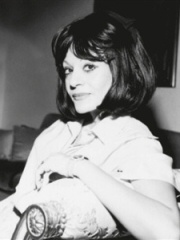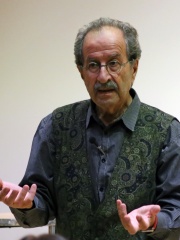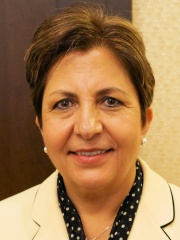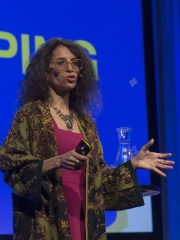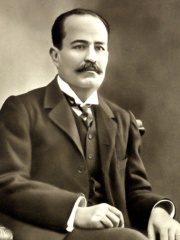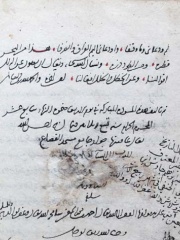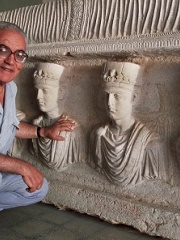
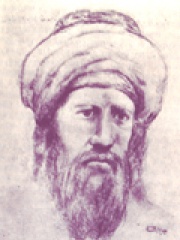
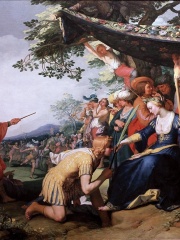
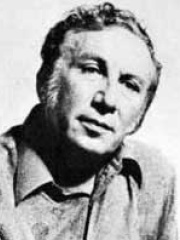
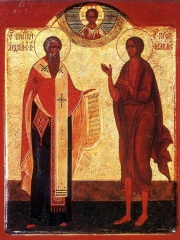

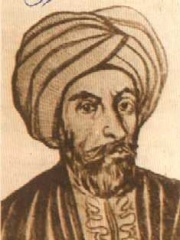

The Most Famous
WRITERS from Syria
Top 10
The following people are considered by Pantheon to be the top 10 most legendary Syrian Writers of all time. This list of famous Syrian Writers is sorted by HPI (Historical Popularity Index), a metric that aggregates information on a biography's online popularity. Visit the rankings page to view the entire list of Syrian Writers.

1. Khaled al-Asaad (1932 - 2015)
With an HPI of 71.78, Khaled al-Asaad is the most famous Syrian Writer. His biography has been translated into 35 different languages on wikipedia.
Khaled Mohamad al-Asaad (Arabic: خالد الأسعد; Arabic pronunciation: [ɐlʔæsʕæd]; 1 January 1932 – 18 August 2015) was a Syrian archaeologist who was head of antiquities in the ancient city of Palmyra, a UNESCO World Heritage Site. He held this position for over forty years. Al-Asaad was publicly beheaded by the Islamic State on 18 August 2015, at the age of 83.

2. Al-Maʿarri (973 - 1057)
With an HPI of 70.73, Al-Maʿarri is the 2nd most famous Syrian Writer. His biography has been translated into 49 different languages.
Abu al-Ala al-Ma'arri (Arabic: أبو العلاء المعري; December 973 – May 1057), also known by his Latin name Abulola Moarrensis, was an Arab philosopher, poet, and writer from Ma'arrat al-Nu'man, Emirate of Aleppo (in present day Syria). Because of his antireligious worldview, he is known as one of the "foremost atheists" of his time", although his worldview was closer to deism. Born in the city of al-Ma'arra (present-day Ma'arrat al-Nu'man, Syria) during the later Abbasid era, he became blind at a young age from smallpox but nonetheless studied in nearby Aleppo, then in Tripoli and Antioch. Producing popular poems in Baghdad, he refused to sell his texts. In 1010, he returned to Syria after his mother began declining in health, and continued writing, which gained him local respect. Described as a "pessimistic freethinker", al-Ma'arri was a controversial rationalist of his time, rejecting superstition and dogmatism. His written works exhibit a fixation on the study of language and its historical development, known as philology. He was pessimistic about life, describing himself as "a double prisoner" of blindness and isolation. He attacked religious dogmas and practices, was equally critical and sarcastic about Judaism, Christianity, Islam, and Zoroastrianism, and became a deist. He advocated social justice and lived a secluded, ascetic lifestyle. He was a vegan, known in his time as a moral vegetarian, entreating: "Do not desire as food the flesh of slaughtered animals / Or the white milk of mothers who intended its pure draught for their young." Al-Ma'arri held an antinatalist outlook, in line with his general pessimism, suggesting that children should not be born to spare them of the pains and suffering of life. Saqt az-Zand, Luzumiyat, and Risalat al-Ghufran are among his main works.

3. Heliodorus of Emesa (250 - 400)
With an HPI of 69.89, Heliodorus of Emesa is the 3rd most famous Syrian Writer. His biography has been translated into 30 different languages.
Heliodorus Emesenus or Heliodorus of Emesa (Ancient Greek: Ἡλιόδωρος ὁ Ἐμεσηνός) is the author of the ancient Greek novel called the Aethiopica (Αἰθιοπικά) or Theagenes and Chariclea (Θεαγένης καὶ Χαρίκλεια), which has been dated to the 220s or 370s AD.

4. Nizar Qabbani (1923 - 1998)
With an HPI of 68.80, Nizar Qabbani is the 4th most famous Syrian Writer. His biography has been translated into 39 different languages.
Nizar Tawfiq Qabbani (Arabic: نزار توفيق قباني, ALA-LC: Nizār Tawfīq Qabbānī; 21 March 1923 – 30 April 1998) was a Syrian poet, diplomat, and publisher. Widely regarded as Syria’s national poet. Qabbani’s work is noted for its blend of simplicity and lyrical elegance, addressing themes of love, eroticism, feminism, religion, Arab nationalism, and resistance to both foreign imperialism and domestic authoritarianism. He remains one of the most celebrated and influential contemporary poets in the Arab world. His notable relatives include the playwright Abu Khalil Qabbani, diplomat Sabah Qabbani, writer Rana Kabbani, and translator Yasmine Seale.
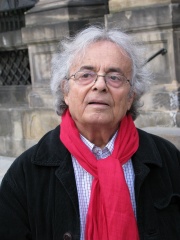
5. Adunis (b. 1930)
With an HPI of 68.71, Adunis is the 5th most famous Syrian Writer. His biography has been translated into 46 different languages.
Ali Ahmad Said Esber (Arabic: علي أحمد سعيد إسبر, North Levantine Arabic: [ˈʕali ˈʔaħmad saˈʕiːd ˈʔesbeɾ]; born 1 January 1930), also known by the pen name Adonis or Adunis (أدونيس [ʔadoːˈniːs]), is a Syrian poet, essayist and translator. Maya Jaggi, writing for The Guardian stated "He led a modernist revolution in the second half of the 20th century, "exerting a seismic influence" on Arabic poetry comparable to T.S. Eliot's in the anglophone world." Adonis's publications include twenty volumes of poetry and thirteen of criticism. His dozen books of translation to Arabic include the poetry of Saint-John Perse and Yves Bonnefoy, and the first complete Arabic translation of Ovid's "Metamorphoses" (2002). His multi-volume anthology of Arabic poetry ("Dīwān ash-shi'r al-'arabī"), covering almost two millennia of verse, has been in print since its publication in 1964. A perennial contender for the Nobel Prize in Literature, Adonis has been described as the greatest living poet of the Arab world.

6. Andrew of Crete (660 - 740)
With an HPI of 68.16, Andrew of Crete is the 6th most famous Syrian Writer. His biography has been translated into 25 different languages.
Andrew of Crete (Greek: Ἀνδρέας Κρήτης, c. 650 – July 4, 712 or 726 or 740), also known as Andrew of Jerusalem, was an 8th-century bishop, theologian, homilist, and hymnographer. He is venerated as a saint in both the Eastern Orthodox Church and the Catholic Church.

7. Herodian (170 - 250)
With an HPI of 67.46, Herodian is the 7th most famous Syrian Writer. His biography has been translated into 35 different languages.
Herodian or Herodianus (Greek: Ἡρωδιανός), sometimes referred to as Herodian of Antioch (c. 170 – c. 240), was a minor Roman civil servant who wrote a colourful history in Greek titled History of the Empire from Marcus onwards (τῆς μετὰ Μάρκον βασιλείας ἱστορία) in eight books covering the years 180 to 238. His work is not considered entirely reliable, although his less biased account of Elagabalus may be more useful than that of Cassius Dio. The origin of Herodian is contested in scholarship, popular hypotheses being Syria, Alexandria in Egypt and Asia Minor. However, he appears to have lived for a considerable period of time in Rome, possibly without holding any public office. From his extant work, it seems that he was still living at an advanced age during the reign of Gordianus III, who ascended the throne in 238. Beyond this, nothing is known of his life. Herodian writes (1.1.3; 2.15.7) that the events described in his history occurred during his lifetime. Photios I of Constantinople (Codex 99) gives an outline of the contents of this work and passes a flattering encomium on the style of Herodian, which he describes as clear, vigorous, agreeable, and preserving a happy medium between an utter disregard of art and elegance and a profuse employment of the artifices and prettinesses which were known under the name of Atticism, as well as between boldness and bombast. He appears to have used Thucydides as a model to some extent, both for style and for the general composition of his work, often introducing speeches wholly or in part imaginary.

8. Abu Tammam (788 - 846)
With an HPI of 66.21, Abu Tammam is the 8th most famous Syrian Writer. His biography has been translated into 35 different languages.
Ḥabīb ibn Aws al-Ṭā’ī (حبيب بن أوس الطائي; ca. 796/807 - 845), better known by his sobriquet Abū Tammām (أبو تمام), was an Arab Muslim poet. He is well known for compiling the Hamasah, which is considered to be one of the greatest anthologies of Arabic literature ever assembled. The Hamasah contained 10 books of poems, with 884 poems in total.

9. Cassius Longinus (213 - 273)
With an HPI of 65.96, Cassius Longinus is the 9th most famous Syrian Writer. His biography has been translated into 26 different languages.
Cassius Longinus (; Greek: Κάσσιος Λογγῖνος; c. 213 – 273 AD) was a Greek rhetorician and philosophical critic. Born in either Emesa or Athens, he studied at Alexandria under Ammonius Saccas and Origen the Pagan, and taught for thirty years in Athens, one of his pupils being Porphyry. Longinus did not embrace the Neoplatonism then being developed by Plotinus, but continued as a Platonist of the old type and his reputation as a literary critic was immense. During a visit to the east, he became a teacher, and subsequently chief counsellor to Zenobia, queen of Palmyra. It was by his advice that she endeavoured to regain her independence from Rome. Emperor Aurelian, however, crushed the revolt, and Longinus was executed.

10. Usama ibn Munqidh (1095 - 1188)
With an HPI of 64.90, Usama ibn Munqidh is the 10th most famous Syrian Writer. His biography has been translated into 25 different languages.
Majd ad-Dīn Usāma ibn Murshid ibn ʿAlī ibn Munqidh al-Kināni al-Kalbī (also Usamah, Ousama, etc.; Arabic: مجد الدّين اُسامة ابن مُرشد ابن على ابن مُنقذ الكنانى الكلبى) (4 July 1095 – 17 November 1188) or Ibn Munqidh was a medieval Arab Muslim poet, author, faris (knight), and diplomat from the Banu Munqidh dynasty of Shaizar in northern Syria. His life coincided with the rise of several medieval Muslim dynasties, the arrival of the First Crusade, and the establishment of the crusader states. He was the nephew and potential successor of the emir of Shaizar, but was exiled in 1131 and spent the rest of his life serving other leaders. He was a courtier to the Burids, Zengids, and later Ayyubids in Damascus, serving Zengi, Nur ad-Din, and Saladin over a period of almost fifty years. He also served the Fatimid court in Cairo, as well as the Artuqids in Hisn Kayfa. He travelled extensively in Arab lands, visiting Egypt, Syria, Palestine and along the Tigris River, and went on pilgrimage to Mecca. He often meddled in the politics of the courts in which he served, and he was exiled from both Damascus and Cairo. During and immediately after his life, he was most famous as a poet and adib (a "man of letters"). He wrote many poetry anthologies, such as the Kitab al-'Asa ("Book of the Staff"), Lubab al-Adab ("Kernels of Refinement"), and al-Manazil wa'l-Diyar ("Dwellings and Abodes"), and collections of his own original poetry. In modern times, he is remembered more for his Kitab al-I'tibar ("Book of Learning by Example" or "Book of Contemplation"), which contains lengthy descriptions of the crusaders, whom he interacted with on many occasions, and some of whom he considered friends. Most of his family was killed in an earthquake at Shaizar in 1157. He died in Damascus in 1188, at the age of 93.
People
Pantheon has 28 people classified as Syrian writers born between 170 and 1971. Of these 28, 7 (25.00%) of them are still alive today. The most famous living Syrian writers include Adunis, Ghada al-Samman, and Rafik Schami. The most famous deceased Syrian writers include Khaled al-Asaad, Al-Maʿarri, and Heliodorus of Emesa. As of April 2024, 1 new Syrian writers have been added to Pantheon including Khaled Khalifa.
Living Syrian Writers
Go to all RankingsAdunis
1930 - Present
HPI: 68.71
Ghada al-Samman
1942 - Present
HPI: 59.49
Rafik Schami
1946 - Present
HPI: 57.77
Zakaria Tamer
1931 - Present
HPI: 56.20
Wafa Sultan
1958 - Present
HPI: 55.18
Samar Yazbek
1970 - Present
HPI: 51.47
Dima Khatib
1971 - Present
HPI: 45.40
Deceased Syrian Writers
Go to all RankingsKhaled al-Asaad
1932 - 2015
HPI: 71.78
Al-Maʿarri
973 - 1057
HPI: 70.73
Heliodorus of Emesa
250 - 400
HPI: 69.89
Nizar Qabbani
1923 - 1998
HPI: 68.80
Andrew of Crete
660 - 740
HPI: 68.16
Herodian
170 - 250
HPI: 67.46
Abu Tammam
788 - 846
HPI: 66.21
Cassius Longinus
213 - 273
HPI: 65.96
Usama ibn Munqidh
1095 - 1188
HPI: 64.90
Jurji Zaydan
1861 - 1914
HPI: 64.33
Ahmad ibn Arabshah
1389 - 1450
HPI: 64.28
Alciphron
200 - 200
HPI: 63.19
Newly Added Syrian Writers (2025)
Go to all RankingsOverlapping Lives
Which Writers were alive at the same time? This visualization shows the lifespans of the 8 most globally memorable Writers since 1700.

